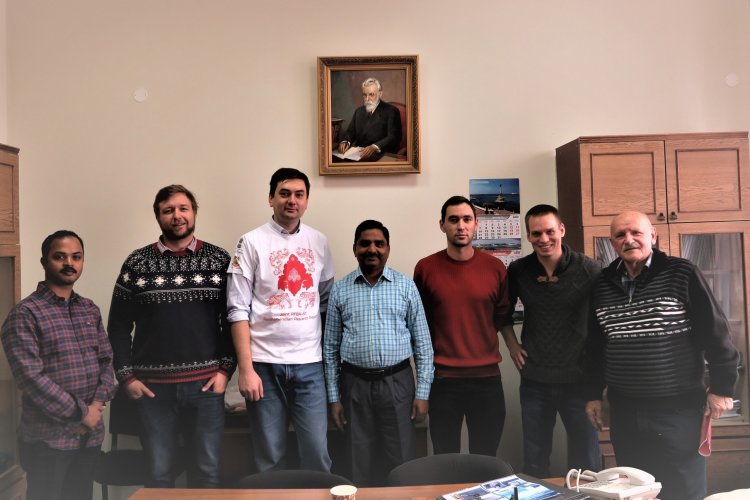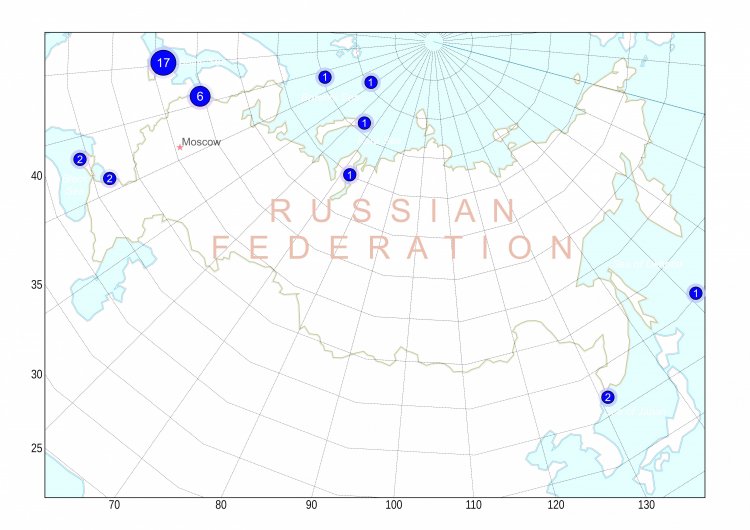Specialists of the Marine Hydro-Physical Institute (Sevastopol) perform research devoted to microplastic contamination of sea environment on Russia’s territory. The research has shown a relatively high pollution level in the Baltic Sea, especially if compared to the basin of Arctic Region and once again confirmed the need for working out some standard methods for the identification and selection of microplastic.
The issue on microplastic contamination of the world ocean was raised about 10 years ago. The species with habitat in water environment and on the sea surface are still at risk. The study of water basin pollution shows the adverse effect of microplastic on continental water systems. The seas of Atlantic, Pacific and Arctic oceans that wash Russia’s territory become the objects of ecological threat too. The marine economic activities, flux of the plastic litter from the coasts and existing problems of production waste utilization do damage to aquatic areas and adjacent waters.
International project Identification and Modeling of Microplastic Transportation in Coastal Area under the Impact of Prevailing Atmospheric Circulation (2018-2020) developed under the grant of the Russian Foundation for Basic Research (RFBR) was aimed at finding out how much plastic was accumulated in the coastal area, and how winds controlled its transfer. The work was performed jointly with foreign colleagues from Annamalai University (Chennai, India) and University of Qatar, who initiated the cooperation (Dr. S. Veerasingam). Andrey Vladimirovich Bagayev acted as research manager from the Russian side. The project participants included the employees of Marine Hydro-Physical Institute (Sevastopol) and Kovalevsky Institute for Biology of Southern Seas, RAS (Sevastopol). The comparative analysis carried out jointly with the scientists from the Atlantic Subdivision of Shirshov Oceanology Institute (Kaliningrad), which reflects the data on the presence of microplastic in Russia’s seas, was published by international journal ENVIRONMENTAL SCIENCE AND POLLUTION RESEARCH, 2021 (https://doi.org/10.1007/s11356-021-14183-z).
Andrey Vladimirovich Bagayev, candidate of physics and mathematics, senior research fellow at the Marine Hydro-Physical Institute (Sevastopol) highlighted what exactly the monitoring of scholar papers on microplastic contamination had shown, and, in particular, the present situation in this sphere, and quoted the seas that were most often exposed to this type of pollution. He also demonstrated how the inconsistency of methods led to a gap in the studies.
What is the reason behind the interest in performing the analysis of current situation with regard to plastic pollution of aquatic environment? What will be the use of this information?
“There are two aspects of carrying out such analysis. First, we, as researchers, are interested in comparing the pollution levels in our region (Sevastopol) with the ones observed in other areas (Baltic Sea, Arctic, and the Far East). Actually, a similar paper for Indian coast was published first. We were its co-authors rendering aid to our colleagues in materials generalization. While developing this project, we studied the contamination of Russian waters with plastic together. Besides, we engaged our colleagues from the most experienced and advanced laboratory of the Atlantic Subdivision, Shirshov Oceanology Institute (Kaliningrad). Actually, they had accomplished the majority of field studies before, so we often asked the authors of scholar papers to specify some moments.
From the communication with colleagues and thanks to intuition, we understood that in 2019-2020 many projects dealing with plastic and microplastic contamination had already been launched. However, there were few serious papers. On the background of pandemic, a sort of lull before the storm was observed. Put it differently, we should expect a lot of interesting studies and publications. In fact, they have already started coming out. I mean the ones devoted to the Arctic, Baikal, and Azov Sea. When we were drawing our survey, however, there were no such papers yet, so we believed that our study would become a sort of milestone. We hope that our paper will help the colleagues to verify concentration figures, check the methods of samples collection, etc.,” Andrey Bagayev explained.
Photo showing the project participants from India (Annamalai University, Chennai) – professor Ramadoss Venkatachalapathy (center) and doctor Guganathan Loganathan (far right) with colleagues from Marine Hydro-Physical Institute (Sevastopol) during their visit to Russia. Project manager A. V. Bagayev is the third from the left, project participant A. I. Mizyuk – the second from the left. The photo was taken at the Marine Hydro-Physical Institute during the meeting devoted to the prospects of further cooperation.
Photo from the archive of Andrey Bagayev.
The scientists examined 32 papers dealing with plastic pollution of water and bottom sediments in Russia’s seas published over the period from 2015 to August of 2020 and prepared a survey using such criteria, as samples collection methods, extraction processes, identification techniques, amount and characteristics of microplastic. Most of the articles are about the contamination of Baltic Sea, because, as Andrey Bagayev explained, “the laboratories dealing with studies of plastic pollution and respective measurements have been founded in the Baltic region earlier, and these papers immediately become visible during the search, as their authors are renowned scientists having a lot of publications.”
Which of the Russian seas or basins of Atlantic, Pacific, and Arctic oceans are leading in both the highest and lowest concentration of microplastic in aquatic environment?
“The Baltic Sea showed the highest concentration, just because the respective research was the most scrupulous. The Black and Azov seas can be considered the cleanest ones so far. New papers offer new figures. As for personal messages, several people told me about litter patches, i.e., plastic soup, yet I would not believe them until I can see these patches with my own eyes or read about them in serious periodicals.
As for our parts of the Arctic and Pacific Ocean, only spot analysis has been performed with regard to them. The concentration values in these areas are much lower than the peak figures for the Baltic Sea, or, say, typical levels for India, China, Great Garbage Patch, and the Mediterranean. I can add that this fact often triggers skepticism at academic conferences. The skeptics say that there is no point in studying the problem of plastic pollution, if Russian seas are so clean,” the scientist said.
Which marine area is the most liable to anthropogenic contamination?
“Speaking about beaches, we can make a conclusion that plastic is everywhere. It is true even for distant beaches with no tourists or cities in the vicinity. If you try to pick it up, you will see a lot of plastic. Moreover, the quantities of it will grow,” the scientist is sure.
What is the dynamics with regard to microplastic pollution of the seas for the period of past 5 years?
The map showing the approximate location of studied aquatic area and coasts. Figures in blue circles stand for the number of articles published. Latin inscriptions stand for geographic names: names of seas (except Azov one) mentioned in the paper are written in italic type.
“As for temporal dynamics, it is yet too early to talk about it. One needs to take measurements at the same place many times using the same methods to speak about changes,” Bagayev stressed.
What has the survey of methods shown? What valid techniques or standard procedures for identification and evaluation of microplastic concentration in sea water do we have today?
“The general methods are more or less similar: we sift or filter samples, separate them with regard to density, oxidize in peroxide or acid, filter them once again, and examine under the microscope. It is the simplest way that many scientists choose. It is not so good with regard to standardization, as different measurement units are used: units per liter, square meter, kilo of weight, etc. The screens may also be different. Yet, the main thing lies in the identification of particles. It looks that the best way is to examine polymer spectra, but this process is long, complicated and expensive, so many researchers limit themselves to visual analysis. Well, it definitely is plastic, as the particles are colored and have not dissolved in acid. It is clear that we have full scope for imagination and mistakes here. On the other hand, however, there is scope for development of one’s own methods for both separation of particles and counting them, etc.,” the scientist said.
According to Andrey Bagayev, the main gaps of the studied research papers devoted to plastic contamination of water and bottom sediments in Russian seas are the following: “Mismatching enough methods of samples collection, insufficient number of identified polymer types (for instance, using spectral analysis), and lack of papers devoted to biota, i.e., living organisms.”
What is the importance of working out harmonized standards of studying microplastic concentration in sea water (in particular, methods of samples collection and identification) for solving different research problems?
“It is very important for any type of research work. Otherwise, it is impossible to compare the results. One more essential nuance. It is hard to make a reasonable diagnosis for some sea or beach. Without credible diagnosis, one is not entitled to offering recommendations, except for the most general ones, like do not drop litter, etc.,” Andrey Bagayev believes.
What do you think about further growth in such publications reflecting the problems of microplastic pollution? What is the reason behind the interest of scientists in this problem?
“The interest is partially triggered by the topic’s popularity, low entry barriers, so to say. On the other hand, the reason behind this interest lies in the problem being multifaceted. Look, we have Nature, i.e., something that did not contain plastic until people came, and we have plastic that we find almost everywhere. Then, many questions arise. How has it made into the environment? How is it destroyed? Who eats it? Where do currents bring it to? Where does it accumulate? Which of plastic types are more dangerous? What if…? What should be done to get rid of plastic? What should be done about polluted beaches? Here, the scientists dealing with almost any field of knowledge will find application for their skills if they raise one of these questions seriously!” the Russian scientist is sure.
The debates on the consequences of microplastic’s impact on aquatic ecosystems remain relevant, because there is no accurate quantitative evaluation as to the scale and level of Russia sea basins’ contamination. The monitoring of research showed substantial methodological problems and the current situation that has formed up due to the presence of microplastic in the aquatic and coastal environment.
All photos and pictures are provided by Andrey Bagayev
Photo preview andreykuzmin























